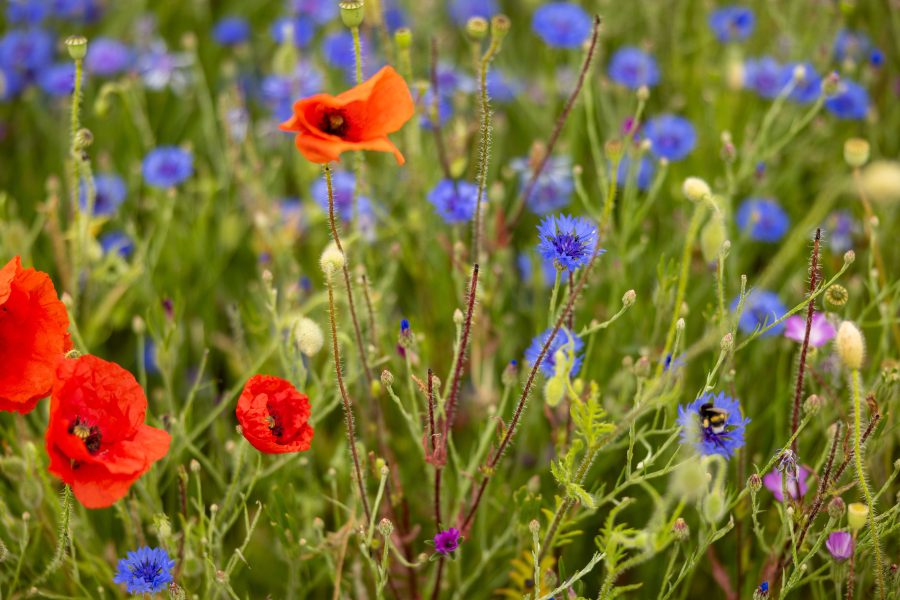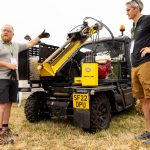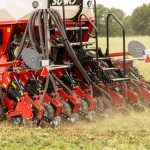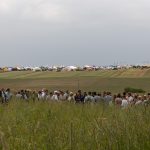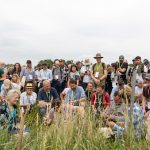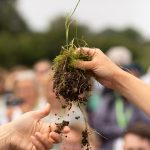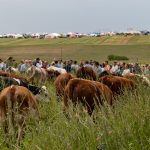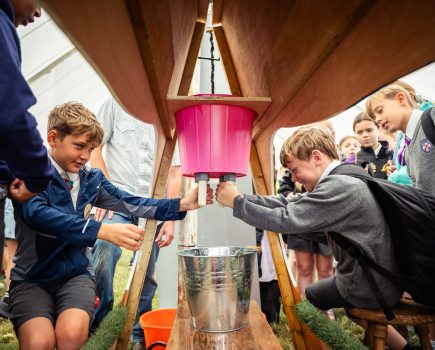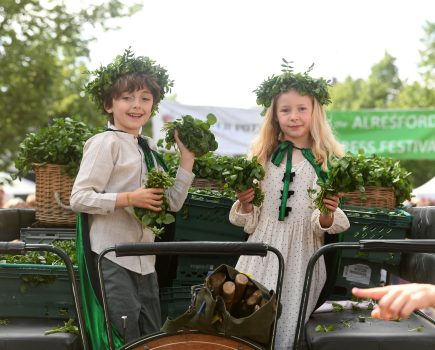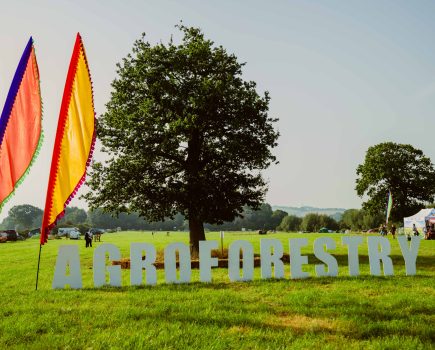Nigel Akehurst attended the 7th Groundswell, held at Lannock Manor Farm in Hertfordshire, to find out if regenerative farming has gone mainstream.
Now in its eighth year, having lost one event to Covid-19, this once small farming show and conference, founded and run by the Cherry family on their mixed arable no-till farm, has become the calendar event for everything “regen ag”. It is, in effect, the “Glasto of farming”.
Whatever your take on the term (and its many meanings), it’s a movement that is attracting a growing audience of farmers, consumers, climate activists, horticulturalists, entrepreneurs, journalists, policy makers and politicians.
This year more than 6,500 people attended Groundswell over two days – nearly double the number from 2021 – with many in their twenties and thirties, making the event feel like a proper festival (especially when you consider that the average age of a farmer is 59).
Another positive sign is the growing number of conventional farmers attending and giving regen ag a go. As event director Alex Cherry pointed out, Groundswell provides an inclusive space for everyone to share their own thoughts and practise ideas and experiences to help make farming part of the solution to many of the issues we face.
To some it comes down to simple economics rather than ideology, though many are motivated to do more to ensure we protect our soil, look after the land and produce food in a safe and nutritious way.
There was an impressive array of large talk tents (nine including a huge big top) and over 200 exhibitors. All the main farming organisations were there – DEFRA, the NFU, the CLA and Nature Friendly Farming Network to name a few.
There were machinery dealers (no-till drills galore), robots, composting businesses, breed societies, software, carbon trading and biodiversity businesses and a few clothing and footwear brands alongside an impressive lineup of sustainable food traders (not a cheap burger van in sight).
Picking what to see
With over 200 speakers and 100 sessions spread over the two days, it was no easy feat picking what to see. The big themes for this year were soil: where it all begins, fibre: fashion is agriculture, biodiversity: from naked eye to AI and last but not least food: discuss and digest. This year Groundswell also ‘popped the cork’ on regenerative viticulture, with two panel sessions exploring what that looks like around the world and in the UK.
I circled four sessions for the first day and three sessions for the second, allowing plenty of time to set up my rickety tent before the rain, chat to some of the exhibitors, attend a couple of nature safaris and see some of the demonstrations (the mobile abattoir).
For newcomers to regenerative agriculture there were some fascinating first principles sessions in the big top and rainfall simulator demos each day (demonstrating what two inches of rainfall does to soils under different management regimes).
Favourite sessions
One of the first sessions I attended was on cluster groups and landscape recovery, a topic I’ve found fascinating since my involvement in our local farm cluster group The Pevensey Farmers and an area that will become increasingly important as farmers are encouraged to work more collaboratively.
Next up, I attended both the hedgerow and pond safaris, two sessions that provided practical ideas to implement on our own family farm. Looking at the colour and structure of the soil underneath the hedgerow (darker and more alive) compared to the middle of the arable field (lighter and lifeless) was illuminating. Speakers also explained the revitalising process of laying or coppicing a “leggy” hedge. Farmers interested in such projects can take advantage of a number of countryside stewardship grants.
With the Government encouraging farmers to explore emerging green finance options, I attended the session on natural capital markets in practice. The audience included a few representatives from “high street” banks (a chap from Lloyds sat next to me said they were keeping a close eye on the market).
Two years ago this topic felt like the Wild West, and for many it’s still a no-go zone. However, listening to the panel of speakers I felt more assured, with growing consensus on everything from baseline metrics (though some questions remain on how to measure them) to tax implications.
The figures sound more enticing too. Units of biodiversity net gain (BNG) are changing hands for tens of thousands of pounds. There are now more providers and crucially more farmers are signing up. I was interested to learn that as yet there is no private mechanism to reward farmers for maintaining existing carbon rich, biodiverse habitats (where there is little potential uplift). As a solution, one of the expert panel speakers, Ivan De Klee, head of natural capital at Nattergal (a sister company to Knepp Castle Estate), suggested that this type of habitat should continue to be protected by public money.
After the session I spoke to a few different natural capital provider exhibitors. Chatting to a representative at Agreena, I learnt that most carbon payments on offer are currently limited to arable farmers going on the regenerative journey (no-till, reducing fertiliser use, planting cover crops etc), though he felt this could change as the market evolves.
Another option, and one that can apply to grassland farmers as well as arable ones, is BNG. A representative on the Environment Bank stand told me they offer landowners on suitable parcels of land £900 a hectare to enter into a 30-year lease. They typically work with blocks of 20 or more hectares to “co-create a biologically diverse habitat bank (BNG units to sell to developers) to safeguard nature and address biodiversity loss across the UK”.
Once the landowner enters into an agreement, they receive a welcome fee and their first year’s rent up front, he explained. Often the farmer can continue to farm the land, as long as it fits the agreed habitat management plan. To get a better understanding of how this works in practice I spoke to Bella Lowes, a new entrant farmer who farms with her husband Toby Diggens in Devon.
Bella told me they were one of the first to enter into an agreement with the Environment Bank back in 2021 on a 25-acre block of industrially farmed land (previously used to produce swedes) and are now in the process of restoring it back to species-rich grassland.
She admitted the 30-year agreement and legal paperwork was initially quite daunting but said ultimately their goal of restoring the land is aligned and said they enjoy a good working relationship with them.
After baselines (using Natural England’s metrics to measure soil health as well as invertebrate and breeding bird surveys) were taken, they agreed a habitat management plan with the ecologist before starting the restoration work (which is all paid for upfront). Initially they grew a crop of barley as a nutrient strip before using green haying to restore the land.
The results have been positive already, she said, with lots of native grasses, though less flowers than they had hoped for so far. They are also still farming the land, using their herd of Ruby Red native cows to mob graze the grassland and spread seed.
“We’re still creating food. A lot of people’s fear is that land gets taken out of traditional good, sensible farming and food production,” she said. Asked about downsides, Bella said there were biodiversity targets written into the agreement that needed to be hit but said that the Environment Bank was incentivised to help farmers succeed.
She added that they might be missing out on making more money (as ultimately the units will probably be sold to a developer for a lot more money than they receive in annual payments) but was also aware that the annual payments are far more than they could earn from producing food.
Selling direct
Having sold beef and lamb direct from our own family farm since 2016, I’ve always found it useful to learn from others in the sector and encourage others to give it a go.
I attended a session entitled Direct to Household: building a market for local food from the farmgate. Two of the farmer panelists selling meat direct recommended offering individual cuts to customers rather than just boxes. They said it had helped them retain more customers, though I can imagine managing carcass balance might be more complicated.
Other suggestions included freezing the meat the day it is collected from the butcher (though there is still work to be done to change the narrative around frozen meat). Abby Allen of Pipers Farm recommended building relationships with journalists to help get the word out. She also suggested using images of cooked meat as well as fresh meat, along with recipe ideas.
All the panelists said social media was key, along with a good website, something you don’t need to spend thousands on with cost effective platforms like the Open Food Network and Oooby worth checking out.
Mobile abattoir
With many farmers in the South East still reeling from the closure of Totttingworth earlier in the year, I was eager to see the mobile abattoir on show at Groundswell.
Attending a demo led by operator Andy Gray, I joined a group interested in finding out whether a modified shipping container on a lorry body could be the answer to our problems.
The abattoir is the first of its kind in the UK and was built in Italy at a cost of £250,000 (though the Government may start offering 40% grants towards the cost, according to Andy). It costs around £60 an hour to staff and run, with a current daily throughput of five cattle or 45 lambs.
As Andy admitted, things get a bit tight with a Belgian blue and a large slaughter man. Walking through the unit later I could see why. These units may well be a good solution for a small island community or remote part of the UK, but I can’t see them being widely adopted in the South East; it’s another reason why we need more support for our existing abattoirs.
The future
I returned home feeling inspired and eager to do more on our own farm. I’ve started digging more holes to look at our soils and am paying more attention to our existing hedges and ponds, working out what we can do to help them attract more wildlife. I’m also determined finally to give adaptive multi-paddock (AMP) grazing a go.
This is the time of the year when I spend the most time in a tractor cab, moving bales or mucking out our cattle yards, and can recommend listening to audio books to help pass the time. I’ve just finished listening to Ravenous by Henry Dimbleby, a book everyone was talking about at Groundswell. Hope to see some of you there next year.

